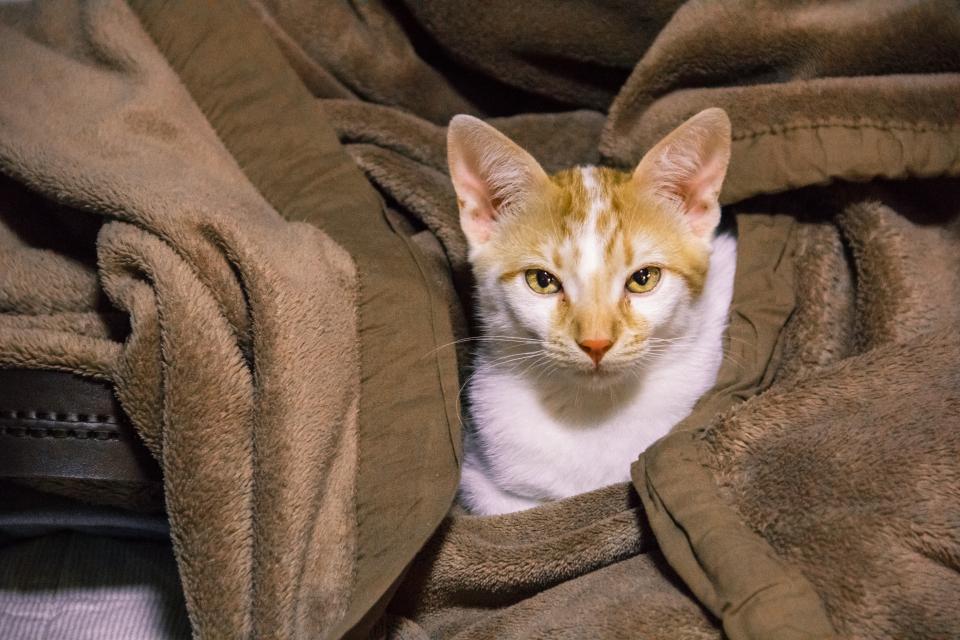This comprehensive guide explores the average lifespan of indoor cats, providing valuable insights into factors influencing longevity and practical tips for extending your feline friend's years. We'll delve into the average lifespan, key contributing factors, common health concerns, and essential preventative measures. Discover how to provide a nurturing environment for your indoor cat to thrive and enjoy a longer, happier life.
Part 1: Understanding the Average Lifespan

1.1. A Long and Happy Life
Indoor cats, generally, enjoy a longer lifespan than their outdoor counterparts. This is primarily due to the reduced exposure to hazards such as traffic, predators, and infectious diseases. The average lifespan of an indoor cat is around 13-17 years. However, several factors can influence individual longevity, including breed, genetics, lifestyle, and healthcare.
1.2. The Influence of Breed on Lifespan
Certain cat breeds are known for their longer lifespans. For example, Siamese cats are renowned for their longevity, often exceeding 20 years. Other long-lived breeds include Abyssinian, Burmese, and Ragdoll. On the other hand, breeds like Persian and Maine Coon often have a slightly shorter lifespan, averaging around 10-15 years.
1.3. Genetics: A Role in Longevity
Genetic factors play a crucial role in determining a cat's lifespan. Just like humans, cats inherit certain predispositions to certain diseases and health conditions. While genetic screening can help identify potential health risks, there's no guarantee of a long life. Nevertheless, it's essential to be aware of any breed-specific health issues and consult a veterinarian for appropriate screening and preventive measures.
Part 2: Lifestyle Factors Affecting Lifespan

2.1. Nutrition: Fueling Longevity
A well-balanced diet is paramount for a cat's overall health and longevity. Providing high-quality cat food formulated to meet their specific nutritional needs ensures they receive the necessary vitamins, minerals, and proteins. Opt for food tailored to their age, breed, and activity level. Avoid feeding your cat human food, as it can contain harmful ingredients and contribute to obesity.
2.1.1. Age-Specific Nutrition
Kittens require a diet rich in protein and fat for growth and development, while adult cats need balanced nutrition to maintain their health. Senior cats, on the other hand, need a diet lower in calories and higher in protein to support their aging bodies.
2.1.2. The Importance of Fresh Water
Always ensure your cat has access to fresh, clean water. Dehydration can lead to various health problems and shorten their lifespan.
2.2. Vaccination: Protection Against Diseases
Vaccinations are crucial for safeguarding your cat from preventable diseases. Consult with your veterinarian about the appropriate vaccination schedule for your cat, which typically includes rabies, feline distemper, and feline leukemia. Regular vaccinations help prevent serious illnesses and contribute to a longer lifespan.
2.2.1. Vaccinations for Kittens
Kittens need a series of vaccinations to build their immune system. The initial series usually begins around 6-8 weeks of age and continues at intervals until they are fully protected.
2.2.2. Booster Shots
Adult cats need booster shots to maintain immunity. The frequency of booster shots depends on the vaccination and your veterinarian's recommendation.
2.3. Regular Exercise: Maintaining Physical Well-being
While indoor cats have a more sedentary lifestyle, regular exercise is crucial for maintaining their physical and mental well-being. Engage your cat in playtime, provide scratching posts for their natural instincts, and consider a cat tree for climbing and exploring.
2.3.1. The Benefits of Playtime
Playtime provides mental stimulation and helps your cat burn off excess energy. Choose toys that encourage active play, such as feather wands, laser pointers, and interactive puzzle toys.
2.3.2. Creating a Safe and Enriching Environment
Provide a variety of toys and climbing structures to keep your cat engaged and entertained. A cat tree allows for climbing, scratching, and surveying their territory, promoting both physical and mental stimulation.
Part 3: Environmental Factors Impacting Lifespan
3.1. Creating a Safe and Secure Environment
Your home should be a safe haven for your cat. Ensure all potential hazards are removed, such as poisonous plants, cleaning chemicals, and unsecured electrical cords. Secure windows and balconies to prevent accidental falls.
3.1.1. Identifying Potential Dangers
Common household hazards include medications, cleaning products, insecticides, and certain plants that can be toxic to cats.
3.1.2. Securing Your Home
Keep windows and balconies closed or install screens to prevent your cat from escaping or falling. Secure electrical cords and wires to prevent chewing and electrocution.
3.2. The Importance of Stress Management
Stress can have a negative impact on your cat's health and lifespan. Create a calm and predictable environment, offering your cat safe spaces to retreat and escape from stressful situations.
3.2.1. Signs of Stress in Cats
Signs of stress in cats can include hiding, aggression, excessive grooming, loss of appetite, and changes in litter box habits.
3.2.2. Minimizing Stressors
Introduce new animals slowly and provide your cat with a quiet and secure space during stressful periods. Avoid loud noises and sudden movements.
Part 4: Common Health Concerns in Indoor Cats
4.1. Obesity: A Leading Health Risk
Obesity is a prevalent health issue in indoor cats due to a sedentary lifestyle and a diet high in calories. Excess weight puts strain on your cat's joints, increases the risk of diabetes and heart disease, and reduces their overall lifespan. Regular exercise and a balanced diet are essential for maintaining a healthy weight.
4.1.1. Recognizing Obesity
A healthy cat has a defined waist and ribs that are easily felt beneath the skin. If you can't feel your cat's ribs or they have a noticeable potbelly, they may be overweight.
4.1.2. Weight Management Tips
Consult your veterinarian to determine a healthy weight for your cat and discuss a weight loss plan. This may involve diet changes, increased exercise, and a combination of both.
4.2. Urinary Tract Infections (UTIs)
UTIs are common in cats, especially females. Symptoms include frequent urination, straining to urinate, and blood in the urine. While treatable with antibiotics, UTIs can be painful and lead to complications if left untreated.
4.2.1. Risk Factors for UTIs
Risk factors for UTIs include obesity, a diet high in magnesium, and a lack of water consumption.
4.2.2. Preventing UTIs
Encourage your cat to drink plenty of water by providing multiple fresh water sources throughout your home. A diet low in magnesium can also help prevent UTIs.
4.3. Dental Disease: A Silent Threat
Dental disease is often overlooked, but it can have a significant impact on your cat's health. Poor oral hygiene can lead to tooth decay, gum disease, and even systemic infections. Regular dental check-ups and brushing are essential for maintaining good oral health.
4.3.1. Signs of Dental Disease
Signs of dental disease include bad breath, red or swollen gums, loose teeth, and difficulty eating.
4.3.2. Dental Care
Brush your cat's teeth regularly with a cat-specific toothpaste and brush. Provide dental chews and toys to help keep their teeth clean.
Part 5: Essential Preventative Measures
5.1. Regular Veterinary Check-ups: Early Detection is Key
Routine veterinary check-ups are essential for early detection and treatment of any underlying health conditions. Your vet can monitor your cat's overall health, screen for common diseases, and address any concerns promptly. Regular check-ups can help identify and manage potential issues before they escalate, contributing to a longer and healthier life.
5.1.1. Frequency of Check-ups
Adult cats should have annual check-ups, while kittens and senior cats may require more frequent visits.
5.1.2. The Importance of Early Detection
Early detection of health problems allows for prompt treatment, which can significantly improve your cat's outcome and lifespan.
5.2. Indoor Parasite Control
While indoor cats are less exposed to external parasites like fleas and ticks, they can still be infected with internal parasites. Consult your veterinarian about appropriate preventative measures, such as deworming medication, to protect your cat from these threats.
5.2.1. Types of Indoor Parasites
Common indoor parasites include roundworms, tapeworms, and hookworms.
5.2.2. Parasite Prevention
Regular deworming medication, as recommended by your veterinarian, can prevent the development of intestinal parasites.
Part 6: FAQs
6.1. Is it better to have an indoor or outdoor cat?
Indoor cats generally have a longer lifespan due to reduced exposure to hazards like traffic, predators, and diseases. However, outdoor cats benefit from fresh air, sunshine, and natural exploration. The best choice depends on your cat's personality, your lifestyle, and the safety of your environment.
6.2. How often should I take my cat to the vet?
Annual check-ups are recommended for adult cats, with more frequent visits for kittens and senior cats. It's also advisable to schedule a vet visit if you notice any changes in your cat's behaviour, appetite, or appearance.
6.3. What are the signs of a healthy cat?
A healthy cat has a shiny coat, bright eyes, clear nose, and alert behaviour. They should have a healthy appetite, regular bowel movements, and maintain a good weight.
6.4. What should I do if my cat suddenly becomes ill?
If you notice any sudden changes in your cat's health, contact your veterinarian immediately. They can assess the situation and recommend the appropriate course of action.
6.5. Can I prevent my cat from getting old?
While you can't stop the natural aging process, you can significantly influence your cat's lifespan and quality of life by providing a healthy diet, regular exercise, a safe environment, and timely veterinary care.
6.6. What can I expect as my cat ages?
As cats age, they may experience changes in their energy levels, appetite, and sleep patterns. They may also develop age-related health conditions like arthritis, kidney disease, and cognitive decline. Regular vet check-ups can help manage these conditions and ensure your cat enjoys a comfortable and fulfilling senior life.
6.7. What are some additional tips for extending my cat's lifespan?
Provide a variety of toys and scratching posts for entertainment and physical stimulation.
Engage your cat in interactive play sessions to keep them mentally stimulated.
Avoid exposing your cat to cigarette smoke and other harmful fumes.
Offer a safe and comfortable place for your cat to sleep and relax.
Be attentive to any changes in your cat's behaviour or appearance, and consult your veterinarian promptly.
By understanding the average lifespan of indoor cats, the factors that influence it, and the necessary preventative measures, you can provide your feline companion with the best possible care and help them live a long and happy life. Remember that every cat is an individual, and their lifespan will vary based on various factors. Consult with your veterinarian for personalized advice and support in ensuring your cat's well-being.
Everyone is watching
-

Are Cat Ribs Flexible? Understanding Their Anatomy
CATS & KITTENSThis article delves into the fascinating world of feline anatomy, exploring the flexibility of cat ribs and ho...
-

Can Cats Eat Bananas? (Everything You Need to Know)
CATS & KITTENSThis article dives into the intriguing question of whether cats can safely enjoy the sweet, yellow fruit, bana...
-

Cat Lifespan: How Long Do Cats Live?
CATS & KITTENSThis comprehensive guide explores the factors influencing the lifespan of our feline companions, providing ins...
-

Can Cats Get COVID-19? What You Need to Know
CATS & KITTENSThis article will delve into the fascinating world of feline COVID-19 susceptibility. We'll explore whether ca...
-

Can Cats Eat Eggs? A Complete Guide to Egg Safety for Your Feline Friend
CATS & KITTENSWhen it comes to treating our furry companions, we all want to ensure we're doing what's best for them. Eggs...
